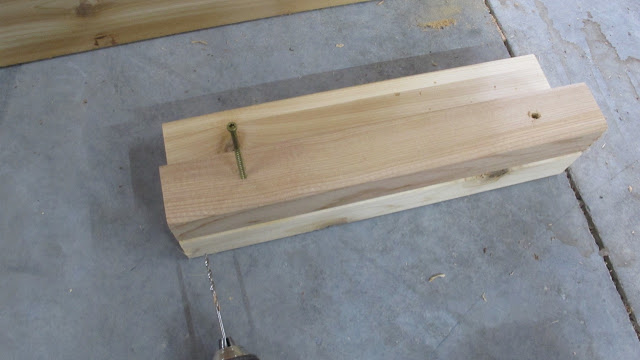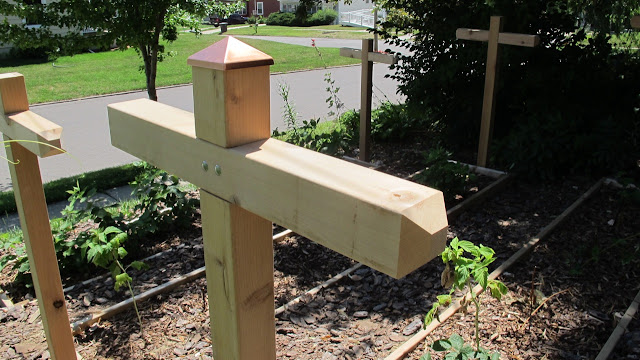 |
| During the winter months, I replaced gardening and bicycling with hiking in our winter home, Arizona. Here's a link to that blog: Tramping Through Hill and Dale. Check back here in March for any new garden updates. |
Wednesday, December 28, 2016
On Vacation for Three-and-a-Half Months
Tuesday, July 26, 2016
Berry Long Boxes (Part 2)
 After leveling and placing the boxes, I set about constructing the trellis structure from which to hang the canes. These would be constructed of 4"x4" cedar, 3.5 feet tall, and 2.5 feet wide.
After leveling and placing the boxes, I set about constructing the trellis structure from which to hang the canes. These would be constructed of 4"x4" cedar, 3.5 feet tall, and 2.5 feet wide.  |
| It helps to have a table saw for the dado cuts. I didn't actually use a dado blade as I was too lazy to put it together. However, a single saw blade makes fairly quick work of it anyway. |
 |
| Cross pieces finished. The dado for the vertical pieces will have to wait until assembly in the yard as I will have to cut the verticals to length beforehand. |
 |
| After the verticals are buried in the ground, I cut them each to the same height—four feet. |
 |
| I measured down six inches for the top of the cross pieces... |
 |
| ... then dadoed each vertical using a circular saw. |
 |
| I then fitted each cross piece before attaching each with two bolts. |
 |
| Much less rood. |
 |
| The final layout looks a lot less like a Roman execution. |
 |
| All that's left to do is to string the wiring. |
Monday, July 25, 2016
Berry Long Boxes (Part 1)
One last piece of garden to terrace in. I had room for three rows of black berries and red raspberries. As with the other spaces, I opted for building cedar boxes to serve as my terraces, in this case three twelve foot by two foot boxes.
 |
| I used 2"x6" twelve foot cedar boards for the long pieces. Side boards are two footers. |
 |
| Corners attached using 2"x4" pieces cut to 5 1/2 inches and screwed in using deck screws. |
 |
| Lastly, 2"x4" two-foot long cross pieces were screwed in to prevent bowing. |
Saturday, May 28, 2016
Six Feet Over (Again)
 The potato boxes one month on. They've loved the biblical rains we've had of late. The pots have all been filled to the brim with soil. Now we wait for the flowers. Attractive plants, I think. And they'll keep us from starving after the Trump apocalypse in the fall.
The potato boxes one month on. They've loved the biblical rains we've had of late. The pots have all been filled to the brim with soil. Now we wait for the flowers. Attractive plants, I think. And they'll keep us from starving after the Trump apocalypse in the fall. |
| Gratuitous picture of Ritchie and Fiona, also one month on. |
 |
| The red fingerling. |
 |
| Overall, the garden is doing quite well, except for Bernie, who's been stifled by the DNC virus. |
Thursday, May 19, 2016
Pici Keen Spring Garlic
Last night called for a special meal: It was my 31st wedding anniversary, and I was also down to the last of my spring garlic. My favorite way to use spring garlic, also called green garlic, is in a simple dish of pasta with olive oil. This lets the subtle green garlic flavor come through unhindered. Spring garlic is to garlic what scallions are to onions, a milder version of the other. I also used the tops, in a big batch of veggie broth.
 |
| I did add a couple of cloves of garlic for a little extra kick. |
 |
| Sauté the garlic in a copious amount of olive oil. I also add a few red pepper flakes to punch it up. |
 |
| For the pasta, I used my favorite, (after my home-made variety): Pici, from Siena, Italy (this via Eataly in Chicago). Pici is a thick hand-rolled spaghetti-like pasta, (think bucatini on steroids, only not hollow). |
 |
| Sprinkle on a little parm and enjoy. |
Tuesday, April 26, 2016
Six Feet Over
Planted my potato boxes yesterday, as well as the potatoes. Terraced and leveled each box into the hillside. These will remain until the apple trees (next to the white buckets) grow large enough to shade the area. Then, I'll have to find a new location (curbside, perhaps?).
 |
| Each box will hold six 5-gallon pots, or five of the 7-gallon variety. |
 |
| I added about four inches of mulch to each pot, then planted three potatoes in each. |
 |
| The top two boxes were planted with the Andean La Ratte white-skinned fingerling; the bottom will contain a red French fingerling (both from Seed Savers Exchange). |
 |
Monday, April 25, 2016
Tater Boxes
Since we cut down Doug, the fir, we have a lot more sunny space to work with in the front yard, at least until the apple trees grow up a bit. I figured I'd try my hand at growing potatoes in pots. So, I bought eighteen industrial grade 5-gallon garden pots (they actually only hold 3.5 gallons, oddly). And, since this is a front-yard garden, aesthetics are important. I thought I could hide the black plastic with some nice cedar boxes, six to a box. The pots are just under 12 inches in diameter, and about 11 inches tall this giving me my rough dimensions. I would add a bit to the width to make room for soil to cover the drain holes as is done in this type of planting. My inside dimensions worked out to 16 inches wide, by 6 feet 2 inches long.
 |
| Pro Cal Pro-can #5s, made in the US of A of recycled materials. |
All of the pieces for all three boxes, sans 1" x 4" cedar finish top trim, cut to length.
 |
| Each end piece was predrilled and screwed with 3-1/8 inch all-weather screws. |
 |
| The T-10 trim-head screws used in this project. Fantastic screws. |
 |
| First box ready for corner pieces. |
 |
| The corner pieces, pre-drilled and screwed together with 2-1/2" screws. |
 |
| The center 2" x 4" is screw from the back (inside the box) using two 2-inch screws. |
 |
| The finish top plate of 1" x 4" cedar required six pieces for the sides, and two for the six end pieces., mitered to fit nicely. |
 |
| I first pre-drilled and screwed each corner using a 3-1/8 inch screw. |
 |
| Finally, I pre-drilled and screwed each board around the perimeter approximately every ten inches. |
 |
| The finished boxes waiting to be terraced into the front lawn. Check back soon for that post. |
Thursday, April 21, 2016
The Sight of Music
 |
The Music garlic I planted last November has come up nicely. It was all we could do to hold back a few cloves of this delicious garlic to plant. We'll face the same dilemma this year.
|
Subscribe to:
Posts (Atom)













